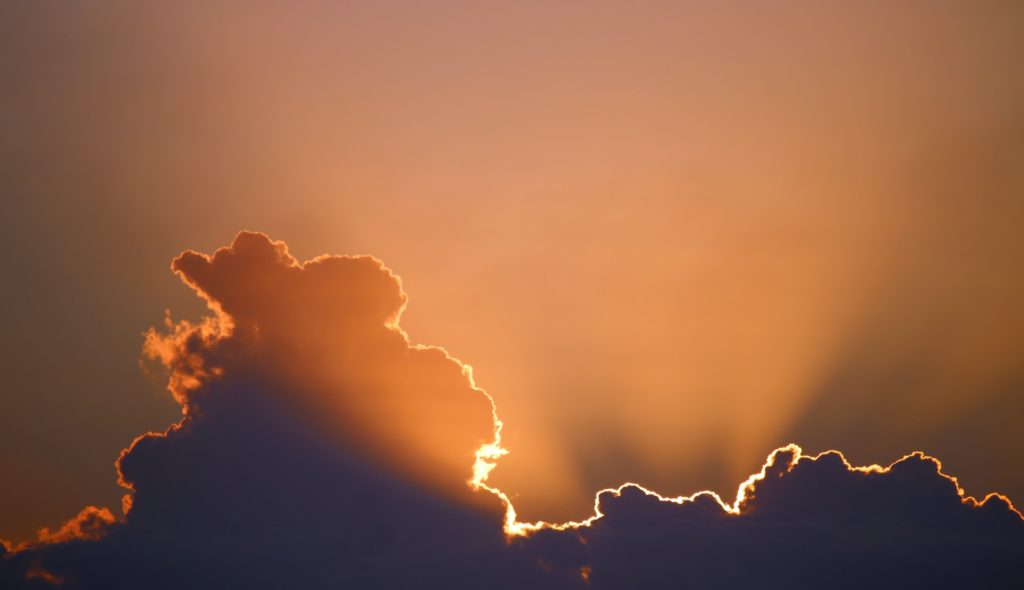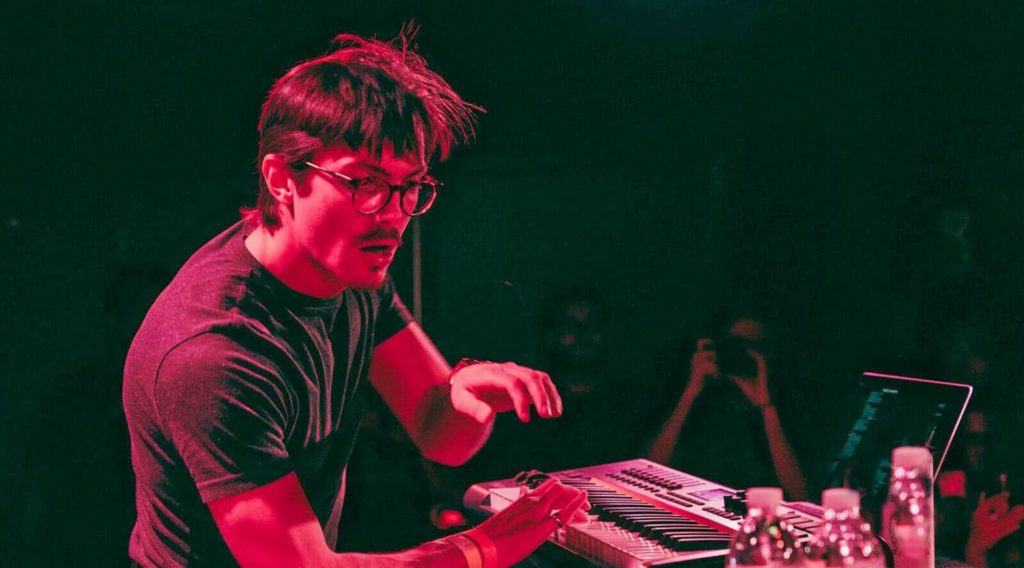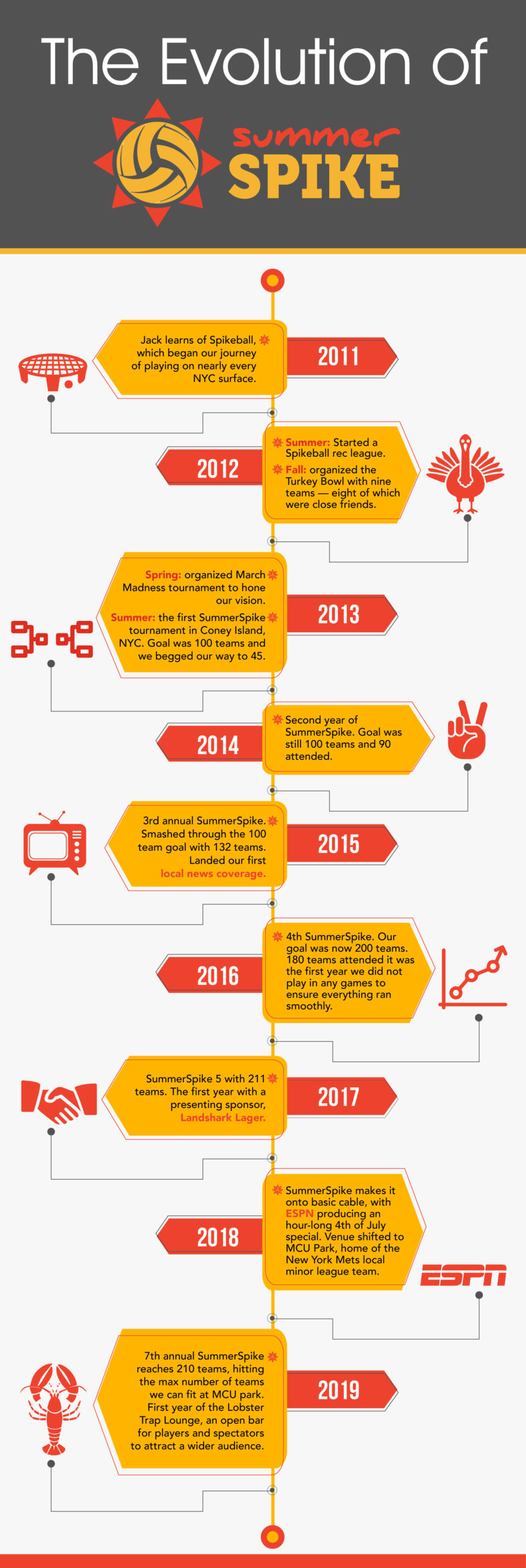You could say I enjoy obscure sports. At the family bar-b-que, you’ll find me outside taking a friendly game of croquet way too seriously. In college, I spent my weekends zig-zagging the country to play Ultimate Frisbee with my club team. Instead of donning a cap and gown with my fellow graduating seniors, I was at the College Nationals tournament. My parents were surprisingly pretty cool about it.
With this resume, it’s no surprise when, in 2011, I became hooked on a new, non-mainstream fascination: Spikeball. What’s more surprising is how some casual pickup Spikeball games evolved into SummerSpike, one of the world’s largest Spikeball tournaments, with 200+ teams from around the world, and an hour-long ESPN2 feature.
Here’s what I learned along the way.
But first, a brief history of how SummerSpike came to be.
Nowadays, when someone learns that I co-host SummerSpike, their reaction is usually, “Oh, that’s super cool, I love Spikeball! I saw it on Shark Tank and my buddies are always playing at the beach.”
But this excitement and familiarity has been a more recent development. Throughout 2011 and 2012, my friends Jack, Melissa, Neville, and I would play Spikeball on every patch of grass, sand, and turf we could find in New York City. Back then, the public reaction to Spikeball was something like, “Hey, sorry to bother you guys…but what’s that game you guys are playing?”
Always happy to spread the love, we’d take a minute to explain.
“This is Spikeball. It’s kind of like beach volleyball but instead of hitting the ball over a net, you hit it onto this trampoline thing. It’s 2 vs. 2, with three hits per team, and no assigned sides or boundaries. Once the ball is served you can move anywhere around the net, 360 degrees. Wanna jump in for a point?”
The brave would join us for a point or two. Everyone else would continue watching with growing intrigue and excitement. Their follow up comment was nearly as predictable as the initial curiosity.
“I gotta get a set for myself. My friend/cousin/daughter would love it. Where can I buy one?”
I’m not sure of the exact moment, but after having this same conversation around 200 times, we had an idea. What if there was a Spikeball event that was circled on your calendar six months in advance? The sport wasn’t yet a household name but what if we could create a tournament that attracted people from around the country while simultaneously creating new fans of the game? The four of us met each other playing Ultimate Frisbee together at the University of Delaware. That sport is centered around weekend-long tournaments with a unique mixture of oddball athletes, competitive games, and equally competitive partying.
In our minds, the model event was held every July in southern New Jersey. It’s a 500 team Ultimate Frisbee tournament on the majestic sands of Wildwood, NJ. It’s tough to put a finger on what makes Wildwood so damn fun. Is it the 5,000 instant friends taking over the beach? The friendly yet intense competition? The quick ocean swim to wash the sand off after every game? Finding new ways to skip the line at the beer garden? The lingering threat of an emergency tetanus shot after stepping on a rusty nail? Really, it’s all of those things magically mixed together to create the perfect event. So we asked ourselves: how can we create that same magic with Spikeball?
To explore that vision, in 2012 we organized a weekly Central Park summer league. Before kicking things off, we sent a cold email to Chris Ruder, CEO of Spikeball, introducing ourselves and our plans for the league. Chris graciously sent us two free sets for prizes. He was amped that we were organizing a community around Spikeball. We were amped to get some free Spikeball sets.
The league sparked new friendships and games that lingered into the long summer evenings. It also confirmed our hypothesis that a big Spikeball event had the potential to be epic. As summer faded into fall, we threw our first official tournament: the Turkey Bowl. With only 9 teams, it was smaller than most Thanksgiving dinners yet was an essential step towards our goal. It helped us learn the basics of how to run a tournament. Between the three of us, we’d attended hundreds of sports tournaments. But playing in an event is very different than coordinating a successful one. We learned lots of little things, like how much space is needed between each set, average game duration, and how to set up a bracket.
After that tournament, we sent a slightly less cold email to Chris, sharing our SummerSpike vision: We were going to throw the world’s largest, and most fun, Spikeball tournament. Thinking back on that email exchange, I imagine that Chris classified our idea as aggressive and a tad unrealistic. Yet his reply was 100% supportive.
“How can I help?”
Inspired by the Lean Startup, we created a landing page to officially announce SummerSpike’s upcoming arrival in the summer of 2013. The page was a simple form to capture the name and email of anyone interested in playing in the world’s largest Spikeball tournament. Chris graciously socialized the page within his Spikeball network and within a month we had hundreds of submissions. It was really happening.
Before making the jump from our 9 team Turkey Bowl to our goal of a 100 team SummerSpike, we organized another tournament in the early spring of 2013. We wanted to run a bigger event to learn more about the logistics and operations of running a large scale tournament. It was mid-March, so it’s name, naturally, was March Madness. I’m not sure I would qualify the 9 team turnout as reaching madness levels, but we continued to learn how to run a smooth tournament and hone our SummerSpike vision.
Here’s what we learned while building towards that vision:
✔️ Start small and iterate. While it was initially disappointing we didn’t hit our 100 team goal until year 3, I’m happy it worked out that way. Our growth was strong and steady which allowed us to build upon the prior year’s success. In fact, I think the long term success of SummerSpike would have been compromised if we hit that 100 team goal right from the jump. When you grow too fast too soon, all processes and assumptions are stressed to the max and quality can be compromised.
✔️ The team is everything. SummerSpike would not have happened without Neville, Melissa, and Jack and I all working together, side-by-side. Well, to be honest, they probably could have done it without me. But then you wouldn’t be reading these words.
Having a strong team that you’re excited to work with makes every challenge feel fun, and everything fun even better. Our success to date can be attributed to two key factors. First, I always know when things go pear-shaped (and something always does) there’s no one else I’d rather go to battle with. Second, our team is balanced, with each of us possessing unique skills. When we needed to (semi-legally) crack open a fire hydrant to quench the thirst of 500 people? Neville, the ex-firefighter, jumped to the task. When we needed to find a way to organize the playing schedule for 211 teams, Melissa channeled her inner John Nash and Beautiful Minded the hell out of it. When we needed to coordinate logistics for a few tons of equipment and merchandise, Jack played air traffic controller.
I asked Jack what makes our team special and he summed it up perfectly. “I think about this a lot. It’s my ideal of what working on a team should be. No one is looking to one-up each other. There are no politics and nothing is gained by individual performance. We’re friends that really clearly know what we’re trying to do and always have each other’s backs.”
✔️ Constantly search for ways to improve, even when everything goes great. Our unofficial post-event debrief takes place at the tournament party, beers in hand, 45 minutes after the last point is scored. Truthfully, I can’t remember a year when we weren’t extremely proud. Despite that cozy, comfortable feeling of achievement, we always hold an official “lessons learned” meeting a few days after the event. No matter how many high fives are shared during the unofficial debrief, we always end up with a full page of improvements for the next year.
Some of the lessons are obvious, like “bring a microphone so people can hear our announcements”. Others are smallI, like “a hand truck would make lugging equipment much easier”. And there’s the year when we decided to finalize our bar budget before cracking open the first beer at the after party — a generally useful life lesson. The relentless hunt for improvement is a crucial reason we’ve been able to create an event that keeps getting better.
✔️ Each year will bring new challenges — embrace them. When you consciously build on prior successes, you’ll usually eliminate the old problems. The reality is that new challenges will always emerge. We’re exceptional at accepting that fact and looking to the horizon to identify the next emerging challenge. Here’s how our challenges evolved over time:
- The first couple years were all about marketing and education. We started a tournament for a non-mainstream sport. How do we get people to show up? Three page marketing plans, Facebook messages, email blasts, sliding into Twitter DMs. Whatever it took to get those first crazy 45 teams to show up.
- Once we hit the 100 team mark, we knew logistics would become increasingly important. Transportation, field setup, and food delivery were all equally essential. Something we underestimated was the difficulty of shipping, storing and transporting 2 tons of Spikeball sets, flags, and merch. Let’s just say Jack became quite friendly with the UPS, U-Haul, and storage facilities of New York City.
- After we hit 200 teams in 2017, our longstanding goal of throwing the biggest tournament possible became less important. We knew we could go big and we didn’t feel attached to that challenge. The sport had naturally grown more popular and reaching 200 teams no longer required our all out effort.
The sooner we could spot these challenges, the sooner we could embrace — and overcome them
✔️ Seek enthusiastic partners. 2018 was a big year for us. ESPN was going to film SummerSpike and air it during their ESPN2 4th of July holiday programming. I think ESPN the Ocho was booked solid that day. I mean, nothing says America like some Spikeball followed by Joey Chestnut eating a record-breaking 74 hot dogs.
We were ecstatic with SummerSpike’s evolution, recognition, and the potential exposure for the sport. But we were also facing some new challenges. Namely, how to fit a film truck, announcers, film crew, and rigging gear on a Coney Island beach with no electricity, running water, or parking. After investigating our options, we narrowed the venue choices down to the beach where we’d always hosted the tournament, and MCU Park, the local minor league stadium of the New York Mets. The rental price was the same for each option but there was one huge difference: MCU Park was excited to work with us. Every question we asked was met with an emphatic “yes!”. Compare that to the city bureaucracy, where every question was met with a referral to another city planning department. We decided to partner with MCU park and we haven’t looked back since.
This desire to forge partnerships based on mutual excitement was no doubt cemented from our ongoing relationship with Spikeball Inc. From that first cold email with CEO Chris, they’ve been a key ingredient in SummerSpike’s success. Those two free summer league sets have evolved into an annual visit from the fully kitted Spikevan to supply sets and swag. Fun fact: Chris is also one of the few SummerSpikers to attend all seven years.
✔️ A guiding principle will help make every decision easier. Call it a mantra, mission statement, or goal — the semantics don’t matter. At the end of the day, you need a guiding principle to fall back upon when making tough decisions.
While planning SummerSpike, our guiding principle has always been the same: How can we create the most fun possible? Whenever we’re at a crossroads, we can cut through the noise and narrow our focus by recalling that mission. I know this sounds like the kind kumbaya idea recommended by The Bobs, but we put it to use in nearly every planning meeting. When decisions linger, someone will bring up our true goal. “If we want SummerSpikers to have the most fun possible, that makes this decision pretty straightforward”. Why are we throwing this tournament? So people have the most fun possible. Great, decision made.
✔️ Find an X Factor. We’ve all been to an event that was kind of fun but still feels like a bit of a rip off. Shout out to every Knicks and Yankees game I’ve ever attended. We wanted to flip that feeling on it’s head. Instead, our goal is for every SummerSpiker to feel that they got their money’s worth — and then some. We want them to ask themselves why we didn’t charge more.
A straightforward way to do this is to take less of a profit and pour that money back into the event. And we certainly do that. But we also learned that once you cover the basics, spending more money doesn’t always equate to more fun. Our approach is to find an “X Factor” — that special something that puts the event over the top. Every year we ask ourselves “what’s our X Factor?” A piñata stuffed with dollar bills? A mini keg trophy for the winner of the after party? A rapper crushing a SummerSpike themed rap over the stadium loudspeakers? All X Factors, and all help create a valuable and memorable experience.
A couple years ago, I was on vacation in Madrid, Spain a few weeks after our fifth successful SummerSpike tournament. I was hanging out in my hostel when I felt a tap on my shoulder.
“Hey!”, I heard from behind, “you’re Dan from SummerSpike, right?”
I spun around and saw Nate, a SummerSpiker who attended four of the past five events. It turned out that he was in town for a wedding and we spent a few minutes catching up since seeing each other at SummerSpike. We were blown away by the crazy coincidence of running into each in a random hostel in a random country across the Atlantic.
“I’m assuming I’ll see you at the next SummerSpike?”, he asked me while heading out the door, “I’m already looking forward to next year!”
That serendipitous moment is when I learned the most important lesson of all: creating something that brings anticipation, excitement, and joy to others makes all the challenges worthwhile. The other stuff you’ll figure out along the way.
Subscribe to stay up-to-date with my latest posts. I’ll send you an email after each post is published, about once a month.





